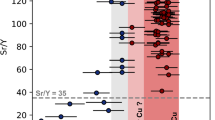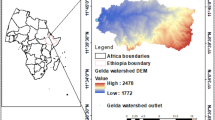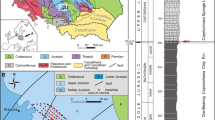Abstract
Applying geostatistical techniques, semivariogram function, and kriging interpolation on the Lower Cambrian–Lower Cretaceous siliciclastic sequence of Jordan yielded a discriminatory diagram that can be utilized to discriminate between the fluvial channel, fluvial floodplain, and shallow marine depositional environments. The mean-sorting index contour values equal to 2.5 or below were found to be indicative of a fluvial channel depositional environment, mean-sorting index contour values above 4.5 may indicate a shallow marine depositional environment, whereas mean-sorting index contour values ranging between 2.5 and 4.5 could indicate a fluvial floodplain depositional environment. The validity of the suggested technique stems from its ability to discriminate between the studied samples of already proven sedimentary environments. Similar studies on other clastic sedimentary rocks would indicate whether this conclusion is valid only for the case study or for all other clastic deposits of different ages, at different locations and of other depositional environments.








Similar content being viewed by others
References
Abed A, Makhlouf I, Amireh B, Khalil B (1993) Upper Ordovician glacial deposits in southern Jordan. Episodes 16:316–328
Amireh BS (1987) Sedimentological and petrological interplays of the Nubian Series in Jordan with regard to paleogeography and Diagenesis. Dissertation, TU Braunschweig
Amireh BS (1997) Sedimentology and paleogeography of the regressive-transgressive Kurnub Group (early cretaceous) of Jordan. Sediment Geol 112:69–88
Amireh BS (2000) The early Cretaceous Kurnub Group Of Jordan: subdivision, characterization and depositional environment development. Neues Jahrbuch Geologisches Und Paläontologisches Monatsheft 2000(1):29–57
Amireh BS (2015) Grain size analysis of the Lower Cambrian-Lower Cretaceous clastic sequence of Jordan: Sedimentological and paleo-hydrodynamical implications. J Asian Earth Sci 97:67–88
Amireh BS, Abed AM (1999) Depositional environments of the Kurnub Group (Early Cretaceous) in Northern Jordan. J Afr Earth Sci 29:449–468
Amireh BS, Schneider W, Abed AM (1994) Evolving fluvial-transitional-marine deposition through the Cambrian sequence of Jordan. Sediment Geol 89:65–90
Amireh BS, Schneider W, Abed AM (2001) Fluvial-shallow marine-glaciofluvial depositional environments of the Ordovician System in Jordan. J Asian Earth Sci 19:45–60
Atkinson PM, Lloyd CD (2012) Geostatistics for environmental applications. Springer, New York
Bandel K (1981) New stratigraphical and structural evidence for lateral dislocation in the Jordan Rift Valley connected with a description of the Jurassic rock column in Jordan. Neues Jahrbuch Geologisches Paläntologisches Abhandlung 3:261–276
Bender F (1968) Geologie von jordanien, 7, Beiträge zur regionalen geologie der erde. Gebrüder Borentrager, Berlin
Bender F, Huckriede R (1963) Stratigraphie der “nubischen sandsteine” in Süd jordanien. Geol Jahrb 18:237–276
Boggs S Jr (1987) Principles of sedimentology and stratigraphy. Merrill Publishing Company, Columbus
David M (1977) Geostatistical ore reserve estimation. Elsevier, Amsterdam
Diggle P (2009) Model-based geostatistics. Springer, New York
Folk RL, Ward WC (1957) Brazos River bar: a study in the significance of grain size parameters. J Sediment Petrol 27:3–26
Friedman GM (1961) Distinction between dune, beach and river sands from their textural characteristics. J Sediment Petrol 31:514–529
Goovaerts P (1999) Geostatistics in soil science: state-of-the-art and perspectives. Geoderma 89:1–45
GS+ (Version 5.1) Geostatistics for the environmental Sciences. Gamma Design Software. Plainwell, Michigan, USA
Hohn ME (2013) Geostatistics and petroleum geology. Springer, New York
Journel A, Huijbregts C (2004) Mining geostatistics. The Blackburn Press, Caldwell, New Jersey
Journel A, Kyriakidis P (2004) Evaluation of mineral reserves: a simulation approach (applied Geostatistics series). Oxford University Press, Oxford
Kitanidis P (1997) Introduction to geostatistics: applications to hydrogeology. Cambridge University Press, Cambridge
Miall AD (1996) The geology of fluvial deposits. Springer, Berlin
Powell J (1989) Stratigraphy and sedimentation of the Phanerozoic rocks in central and south Jordan, part A: Ram and Khreim Groups. Natural Resources Authority, Geological Bulletin No 11, Amman, pp 1–72
Robertson G (2008) Geostatistics for the environmental science. Gamma Design Software, Plainwell, Michigan, USA
Rockworks 15 (2011) Earth Science Software WWW.RockWare.com
Saffarini G, Jarrar G (1998) Quantifying the chemical variability of a Precambrian diabase from south Jordan using stochastic techniques; a proposal. J Volcanol Geotherm Res 85:199–217
Saint-Marc P (1978) Arabian peninsula. In: Moullade M, Nairn AE (eds) The Mesozoic, A. The Phanerozoic of the World II. Elsevier, Amsterdam, pp. 435–462
West C, Mallarino A, Wedin W, Marx D (1989) Spatial variability of soil chemical properties in grazed pastures. Soil Sci Soc Am J 53:784–789
Acknowledgments
The research was supported by the Deanship of the Academic Research of the Jordan University to which we are greatly indebted. The authors would like also to express their sincere appreciation for the anonymous reviewers of the journal and for Dr. Mohamed Khalifa (University of Zawia, Libya) for their useful comments from which the paper has greatly benefited.
Author information
Authors and Affiliations
Corresponding author
Appendices
Appendices
Appendix 1
Appendix 2
Appendix 3
Rights and permissions
About this article
Cite this article
Saffarini, G.A., Amireh, B.S. Distinguishing depositional environments of the Lower Cambrian–Lower Cretaceous siliciclastic sequence of Jordan using geostatistical techniques: A proposal. Arab J Geosci 9, 370 (2016). https://doi.org/10.1007/s12517-016-2365-2
Received:
Accepted:
Published:
DOI: https://doi.org/10.1007/s12517-016-2365-2




